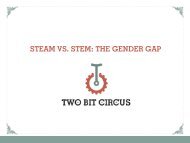EQUITY
2eGXKK2
2eGXKK2
Create successful ePaper yourself
Turn your PDF publications into a flip-book with our unique Google optimized e-Paper software.
or less. Librarians are required to have<br />
knowledge of computers and electronics,<br />
they need to be able to use a variety of<br />
software programs, and need to be able<br />
to communicate with the public, just as<br />
computer user support specialists. The<br />
comparison of librarians and computer<br />
user support staff is of particular relevance<br />
to someone still considering their careers.<br />
A library assistant, for example, a more<br />
junior occupation that shares many<br />
attributes of computer user support tasks,<br />
with median annual earnings of $29,026,<br />
may follow a traditional pathway of six<br />
years of college to become a librarian. Instead<br />
she can opt to build on her experience by<br />
pursuing an associate degree to become<br />
computer user support specialist, which<br />
requires about half of the years in college and<br />
promises annual earnings that are as high if<br />
not higher than librarians.<br />
The lower returns to formal education in<br />
fields which a majority female are also<br />
illustrated by ‘statistical assistants’ and<br />
‘compensation, benefits, and job analysis<br />
specialists’, both occupations which<br />
require a bachelor’s degree, but have lower<br />
median earnings than ‘web developers,’<br />
where an associate degree is the standard<br />
requirement and in which fewer than half of<br />
workers have bachelor’s degrees, according<br />
to O*Net’s database (Table 3.1).<br />
Women’s underrepresentation in information<br />
technology, and other STEM fields, has been<br />
on the policy agenda for a considerable<br />
time. While men and women do not differ<br />
significantly in ability in mathematics and<br />
science, they do differ in perceived skills<br />
and confidence, and in opportunities to<br />
develop their skills and their confidence;<br />
Hill, Corbett, and Rose (2010) provide a<br />
comprehensive review of research on the<br />
factors that lead to women’s and girls’<br />
underrepresentation in computing and other<br />
STEM fields. Policy efforts and research in<br />
information technology fields have typically<br />
focused on schools and colleges, highlighting<br />
how changed teaching styles and resource<br />
allocation can increase girls’ interest and<br />
success in STEM fields. Yet, although women<br />
are less likely than men to have prerequisite<br />
IT skills, there are many women who do,<br />
or who have skills and work experience in<br />
similar fields which provide a stepping stone<br />
to full careers in the sector. Companies<br />
can better ensure that women know about<br />
these opportunities, and that the working<br />
environment doesn’t isolate women but<br />
rather allows them to prosper in the field.<br />
While men and women do not differ significantly in<br />
ability in mathematics and science, they do differ in<br />
perceived skills and confidence, and in opportunities<br />
to develop their skills and their confidence<br />
Attracting women to IT<br />
A 2011 Department of Commerce report cited<br />
that women who work in STEM fields on<br />
average earn 33 percent more than women in<br />
other fields (U.S. Department of Commerce,<br />
2011). Additionally, women working in<br />
STEM jobs face a lower gender wage gap<br />
than women working in many other fields.<br />
Advancing women in IT positions serves as a<br />
crucial pathway into high-paying and fastgrowing<br />
jobs. Women are proportionately<br />
less likely to have jobs in computing than<br />
they were twenty years ago (AAUW, 2015).<br />
Women are less likely than men to work in the<br />
IT industry, and within the IT industry, they<br />
are less likely to work in IT specific positions.<br />
For example, at Google, women make up 30<br />
percent of the company’s total workforce,<br />
and only 18 percent of tech-related positions<br />
(Google, 2015). These numbers illustrate<br />
a challenge in the IT field with attracting<br />
WWW.WOMENANDGOODJOBS.ORG PATHWAYS TO <strong>EQUITY</strong> 23




